The word "Diwali" is derived from the Sanskrit word "Deepavali" meaning "row of lights". While Diwali is popularly known as the "festival of lights",
the spiritual take is "the awareness of the inner light".
The celebration is "victory of good over evil". It refers to the light of higher knowledge dispelling all ignorance.
On top of this, on main Diwali day, goddess of wealth, Lakshmi (Laxmi) is worshipped,
hence this is festival where people show their richness and offer prayers to goddess Lakshmi to bring prosperity
in their life.

The festival spans across five days and the preparation starts a month before. There are various stories behind celebration of Diwali. Some of the significants are:
- According to Hindu Lunar calendar 'New Year' starts on this day.
- Return of Rama to his kingdom after 14 years of long exile after killing demon-king Ravana.
In joyous celebration of the return of their king, the people of Ayodhya, the Capital of Rama, illuminated the kingdom with earthen
diyas and by bursting firecrackers.
- Return of Pandavas after 12 years of Agyatvas (banishment to unknown place) during Mahabharat
- Killing of demon Narakasura by Krishna or his wife Satyabhama

When is Diwali celebrated
Diwali falls on the one new moon night between mid-October and mid-November.
According to Hindu calendar it's new year eve.
Since there is no moon rise this day and the darkness is all around, people lit
their house with candles, lamps and beautiful decorative lights, symbolizing
victory of lights over darkness.
Since Diwali date is based on Lunar calendar, the date changes in the solar (gregorian) calendar every year.
Importance of Diwali
Unarguably Diwali is most famous and widely celebrated festival in Indian and is also popular in other countries like Nepal, Sri Lanka, Myanmar, Mauritius, Guyana, Trinidad & Tobago, Suriname, Malaysia, Singapore and Fiji.
It spans all across diverse culture of India. It also coincides with harvest time in India. People splurge at this time of festival. Each corner of house is cleaned, white washed and decorated. The weather in India is pleasant at this time which supports five joyous day of festivity.
The festival is predominated by colorful display of lights, bursting of crackers, cleanliness, sweets, lots of shopping, happiness.
It is also important for business community. Some business do whole year worth of business just on this festival. In traditional way accounting year starts from this day. People save money all through year to enjoy this festival. It is also believed that gold, silver jewelry and new utensils should be bought during this time to have good fortune all year.
Preparation and essential decorations for Diwali
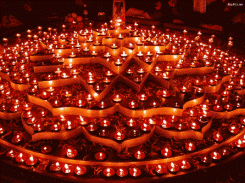
Rows of lamps used for decoration in Diwali
Diya or Deep (from which the name of festival Deepavali ) is small container made our of earth/clay. It is fuelled with oil from coconuts,
mustard or Ghee (clarified butter). The wick is made of cotton. Worship of goddess Lakshmi is done with the lit Diya and also hundreds of
Diyas are places outside of the houese, on floors, balconies, doorways and in each room. In modern time this clay Diyas are being replaced
by electric candle like lamps and also with various modern technical light shows.
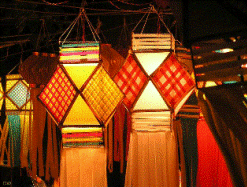
Lighted hangings for Diwali
During Diwali festival, doorways are hung with torans of mango leaves and marigolds. There are designer Torans available now-a-days which are
hung on the front door all year and replaced on Diwali day with new one.
Diwali - Five Days of Celebration
It's the best time of year. Kids get long break during this time. Festival this important does not end on one day.
Day 1: Dhanteras or 'Dhan Trayodashi'
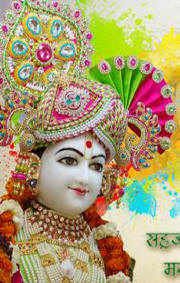
Krishna killed demon on this day
The first day of Diwali celebration is marked by Dhanteras. According to the legends, during the churning of ocean by the Gods and the demons,
Dhanvantari - the physician of the Gods came out of the ocean on the day of Dhanteras, with a pot of amrita (nectar) that was meant for the welfare of the
humankind. This day also marks the arrival of Goddess Lakshmi, which is celebrated by drawing small footprints of the deity, with rice flour and vermilion powder.
This is the day when people buy new utensils and exchange leaves of specific plant symbolizing sharing wealth
Day 2: Narak Chaturdashi (Chhoti Diwali)
One famous story behind the celebrations of Diwali is about the demon king Narakasur, who was ruler of Pragjyotishpur, a province to the South of Nepal.
During a war, he defeated Lord Indra and snatched away the magnificent earrings of Mother Goddess Aditi, who was not only the ruler of Suraloka, but also a
relative of Lord Krishna's wife - Satyabhama. Narakasur also imprisoned sixteen thousand daughters of Gods and saints in his harem. A day before
Diwali, Lord Krishna killed Narakasur, released the jailed daughters and restored the precious earrings of Mother Goddess Aditi.
As the name "Chhoti Diwali" where "chhoti" means small suggests, this day a scaled down version of Diwali is celebrated with less fan-fare.
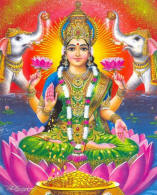
Goddess of wealth Lakshmi
is worshipped on Diwali day
Day 3: Main Diwali (Legends of Ram)
The most famous legend behind the celebrations of Diwali is about the prince of
Ayodhya - Lord Shri Ram. According to the legend, the king of Lanka, Ravan,
kidnapped Lord Ram's wife (Sita) from the jungle, where they were staying as per
the instructions of King Dashratha, father of Lord Ram. Then Ram attacked Lanka,
killed Ravan and released Sita from the custody. He returned to Ayodhya with his
wife Sita and younger brother Lakshamana after fourteen years.
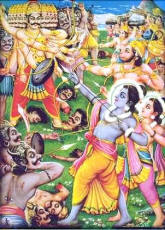
Ram returns to his kingdom on
Diwali day after killing demon Ravana
Therefore, the people of Ayodhyaa decorated their homes as well as Ayodhyaa, by
lighting tiny diyas, in order to welcome their beloved prince Shri Ram and Devi
Sita. It was the day of 'Kartik Amavasyaa' when they also celebrated the victory
of Shri Ram over the King of Lanka, Ravan. Ram is considered the symbol of good
and the positive things and Ravan represents the evils. Therefore, Diwali is
considered the festival, which establishes the victory of good over the evil. On
the night of Diwali, people light diyas, which is again an icon of positive
energy to conquer darkness, the is symbol of negative energy.
On this day, goddess Laxmi is worshipped with Ram and Ganesh. Diyas are
arranged in special way in the puja place. Every community has it's own way of
worship. But everyone in the home wear new cloth for puja, distribute sweets and
touch feet out of respect of elders and relatives. Kids enjoy with fire crackers
in the road, in the front of house and even inside house ladies burn the
lighting crackers. In India there is no restrictions (as yet) to burn fire
crackers in the streets.